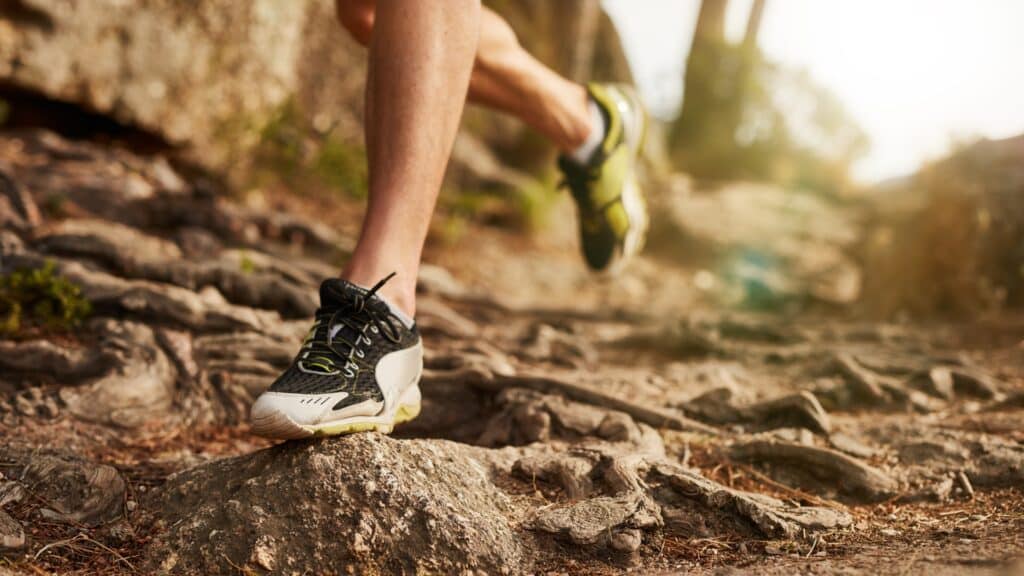
Selecting the ideal hiking boots can significantly enhance your backpacking experience, but with so many options available, where should you begin?
From understanding the different types of hiking boots to exploring various materials and key components, this guide aims to clarify every aspect of your decision-making process.
Whether you're seeking durability, comfort, or a balance of both, each feature and construction detail plays a crucial role in your choice. Curious about how to ensure optimal performance and comfort on the trails? Let's embark on this informative journey to help you make the most informed decision.
When selecting the ideal hiking boots, understanding the different types available is crucial to ensuring comfort and performance on the trails.
Hiking shoes, known for their flexible midsoles, are perfect for day hiking, offering key hiking shoe features like lightweight design and breathability.

Trail running shoes provide benefits for long-distance journeys, including superior traction and cushioning.

For more demanding adventures, backpacking boots offer robust construction to support heavy loads on multiday trips. These boots often include reinforced midsoles and high-cut designs to enhance stability and protection.

Selecting the right type ensures optimal performance and comfort tailored to your hiking needs.
Choosing the right hiking boot materials is essential for ensuring durability, comfort, and performance on the trails. When evaluating materials, consider the trade-offs between waterproof vs breathable features.
Full-grain leather offers exceptional durability and water resistance, making it ideal for rugged terrains, whereas split-grain and nubuck leather provide a balance between durability and breathability.
In contrast, synthetic materials are lighter, dry faster, and have shorter break-in periods, but may not be as durable as leather options. For hikers facing wet conditions, boots with waterproof membranes are recommended, although they may sacrifice some breathability.
Ultimately, the choice between leather vs synthetic depends on the specific needs of the hiker, including the expected trail conditions and personal comfort preferences.
Understanding the key components of hiking boots is crucial for selecting the right pair that meets your specific needs and preferences. When evaluating hiking boots, consider the trade-offs between durability vs. breathability.
Full-grain leather offers superior durability and water resistance but can be less breathable. Conversely, materials like split-grain leather and synthetics provide better ventilation at the expense of long-term durability.
Another critical factor is weight vs. support. Lightweight boots, often made from synthetic materials, offer greater agility and reduced fatigue, ideal for short hikes. However, for extended trips with heavy loads, boots with robust support structures, including firmer midsoles and high-cut designs, are essential for minimizing strain and ensuring stability on rugged terrains.
Considering the key components of hiking boots is just the beginning; understanding their specific features and benefits will help you make an informed decision tailored to your needs.
Breathability vs. waterproofing is a crucial consideration: breathable materials like synthetics and split-grain leather keep feet cool, while waterproof membranes offer protection in wet conditions.
Durability vs. lightweight is another trade-off; full-grain leather provides robust durability, whereas synthetic materials are lighter and quicker to break in.
Vegan vs. leather options cater to ethical preferences, with vegan boots being eco-friendly and breathable.
Stability vs. flexibility is vital for different terrains; high-cut boots provide stability, while flexible midsoles enhance comfort for natural movement. Each feature aligns with specific hiking requirements.
Examining the construction and deals of hiking boots reveals critical insights into their performance and cost-effectiveness. Boot durability is paramount, with midsoles made from EVA providing lightweight cushioning, while polyurethane midsoles offer enhanced longevity. Outsoles typically feature rubber with additives like carbon for increased hardness and a lug pattern that improves grip. Features such as heel brakes enhance stability, particularly on descents.
For those engaged in bargain hunting, discounts on popular brands, clearance sales, and seasonal promotions present valuable opportunities to acquire high-quality boots at reduced prices. Additionally, bundle offers can provide substantial savings, making it easier to find durable, well-constructed hiking boots within budget constraints. This combination of construction excellence and strategic deals ensures both performance and affordability.
Selecting the appropriate hiking boots involves understanding various types suited for specific hiking needs. Evaluating materials for durability and weight is crucial. Consider key features such as breathability, waterproofing, and stability.
Attention to construction details, including midsole and outsole designs, further enhances performance and comfort. By thoroughly assessing these factors and seeking quality deals, one can ensure the acquisition of optimal hiking footwear for any trail adventure.
Hiking boots should fit snugly around the heel and midfoot while providing ample toe room to prevent blisters. Proper arch support is crucial for reducing fatigue and ensuring comfort and performance on extended hikes.
To properly break in new hiking boots, wear them indoors with appropriate socks, gradually increase usage, and address any heel slippage by adjusting laces. Ensure adequate ankle support by tightening laces and using supportive insoles if necessary.
Maintaining and cleaning hiking boots involves regular cleaning with mild soap and water, applying appropriate waterproofing techniques, and storing them in a cool, dry place. Regularly inspect for damage and reapply waterproof treatments as needed.
To prevent blisters while wearing hiking boots, ensure proper lacing techniques to minimize friction and movement. Additionally, apply foot lubrication to reduce skin irritation and wear moisture-wicking socks to keep feet dry.
For optimal comfort and blister prevention, choose hiking socks made from moisture-wicking materials such as merino wool or synthetic blends. Sock thickness should vary based on weather conditions and personal preference, providing adequate cushioning and insulation.
